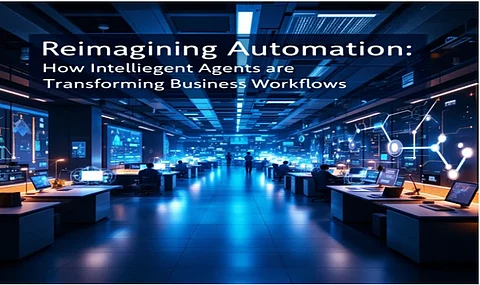

In today's world, Ravindra Reddy Madireddy, a seasoned researcher with extensive experience, explores the dynamic evolution of automation technologies and their transformative impact on modern enterprise systems, including supply chain optimization, intelligent workflows, and decision-making processes across diverse industrial sectors.
Automation has come a long way from its roots in mechanical task execution. Early efforts like Robotic Process Automation (RPA) helped organizations streamline routine processes. Yet, despite offering tangible benefits like cost reductions and processing speed improvements, RPA remained constrained within the realm of structured, repetitive tasks. It faltered when confronted with ambiguity, unstructured data, or scenarios requiring human judgment.
Enter Agentic Process Automation (APA) a leap forward in workflow intelligence. This innovative paradigm discards the rigidity of rule-based systems in favor of autonomous agents capable of learning, adapting, and evolving within dynamic environments.
At the core of APA lies a radically different architectural design. Drawing inspiration from biological and computational models, APA systems are built upon layers that separate perception, decision-making, and action. These modular structures allow for specialization and adaptability, promoting efficiency in environments too complex for monolithic systems.
A defining trait of APA is its decentralized decision-making. Unlike traditional models where logic is centralized, APA disperses intelligence across multiple agents. These semi-autonomous units interact and negotiate responsibilities, enabling a system that is more resilient, scalable, and capable of evolving without collapsing under its own complexity.
The infusion of machine learning into APA frameworks creates systems that not only execute but also reflect and refine. Agents with supervised, unsupervised, and reinforcement learning can recognize patterns, predict outcomes, and adapt behaviors without human prompts.
This cognitive layer enables APA to handle unstructured inputs and changing conditions, making it vital for enterprises facing constant change. However, such autonomy also demands explainability and ethical oversight. Organizations must ensure these systems are transparent and accountable, especially in regulated sectors.
One of APA’s most revolutionary contributions is its model of multi-agent collaboration. Instead of operating in silos, agents communicate through standardized protocols to share insights, delegate tasks, and coordinate efforts. This interconnected web of intelligent actors enables the emergence of complex, adaptive behaviors beyond the reach of single-task systems.
Collaborative frameworks enhance flexibility, with agents dynamically redistributing work based on shifting priorities, workloads, or failures. This fluidity mirrors real-world teams and underscores APA’s alignment with human-like problem-solving.
Compared to conventional RPA, APA systems are not just more intelligent they are more responsive. While traditional automation cracks under the pressure of evolving processes, APA thrives. It adapts on the fly, recalibrates strategies, and maintains operational effectiveness even when business landscapes shift.
The cost-benefit balance also shifts in favor of APA over time. Though its initial setup may demand greater investment, the long-term returns stemming from decreased maintenance and increased adaptability justify the shift for organizations with complex, variable workflows.
Across sectors, APA proves its versatility. In finance, it uncovers fraudulent patterns by mining transactional data. In healthcare, it streamlines patient care through intelligent triaging. In manufacturing, it adapts production schedules based on real-time inputs. These implementations show APA is not confined to specific industries; it is a universal enabler of efficiency and insight.
Strategically deployed, APA improves metrics like cycle time and accuracy while enhancing agility and user experience. Its ability to operate independently yet align with human oversight makes it a trustworthy partner in digital transformation.
Looking ahead, APA’s integration with legacy systems remains a critical step. Layered strategies that combine RPA with cognitive agents ensure a smooth transition. Meanwhile, governance models anchored in transparency and ethics are evolving to guide this new class of automation.
Technological convergence is further expanding APA’s reach. Advances in natural language processing, computer vision, and large language models are making agents even more capable. Additionally, low-code platforms are empowering non-technical users to shape automation processes, democratizing innovation within organizations.
For effective APA realization, the implemented approach for strategic planning is an assured shot. It includes a proper readiness assessment, standardization of process, and huge investments in workforce development between the digital agents. Best practice has revealed the structuring of Centers of Excellence alongside phased approaches to fast-track adoption. Eventually, APA is not just a tool-it is a mindset shift, which involves an organization to think about automation holistically across technical, operational and human dimensions. If the project meets the criteria, it provides scalable, adaptable, innovative potential.
Ravindra Reddy Madireddy concludes that in a perpetually changing scenario, an organization has to embrace this omnipotent transformational capability as the pivot to a future-ready operation, thereby considering the philosophy that automation, in a world jammed with change, should not just follow commands but think.
